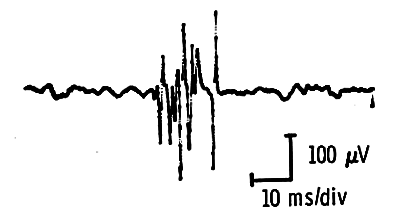When a muscle fiber
is denervated, several pathological changes take place.
The acetylcholine receptors spread all across the muscle
fiber instead of being grouped in a well-defined geographical
area, the end-plate. This spread may play a role in
attracting new innervation to the denervated muscle
fiber from adjacent nerve sprouts. The muscle fiber
becomes much more sensitive to free acetylcholine released
spontaneously from adjacent nerve fibers and is depolarized
and repolarized spontaneously as these molecules reach
it. Each single depolarization is electrically detected
as a single muscle fiber action potential.
The Positive Sharp Wave
This wave represents
a very sharp positive deflection off the baseline
followed by a slower return and often a negative phase
before returning to the baseline.

Positive sharp waves may reach up to 1 mv in amplitude
and can last up to 50 msec. They discharge in a very
rhythmic manner. Usually the rhythm starts and stops
abruptly, and rarely does the individual rhythm vary.
The Fibrillation Potential
Of short duration
(<3 msec) and low amplitude (<300 µv),
fibrillation potentials occur in semirhythmical runs
(<30/second), though occasionally the frequency
is so slow it appears to be random.

With any new needle movement they may be activated
again. Fibrillations are not seen immediately but
develop two to three weeks after the neuron or axon
has been damaged. Muscles closer to the neuraxis will
develop them earlier than those in the distal part
of the extremities. At times, the fibrillations have
been reported as long as twenty years after denervation,
though they are less frequently seen as time goes
by and may be seen infrequently after three years.
As the muscle is reinnervated, both fibrillations
and positive waves decrease in numbers and eventually
disappear as reinnervation is successfully completed.
Fasciculations
A spontaneous
discharge of an entire unit in a random fashion, the
fasciculation looks like any motor unit seen but is
distinguished by the irregular discharge pattern,
and occurs spontaneously. Because many so-called fasciculations
are nothing but units from poorly relaxed muscle,
it is best to try and observe them clinically first.
A genuine fasciculation will induce a noticeable needle
movement when it occurs, whereas a poor relaxation
causes little or no needle displacement. Fasciculation
potentials can be monophasic or diphasic, looking
like normal motor units, or highly polyphasic and
complex, looking like neurogenic motor units. The
former, the so-called benign fasciculations, are usually
seen in normal persons having fatigue or muscle cramps
and usually occur at 0.8 second intervals. The latter,
the so-called malignant fasciculations, are seen most
frequently in anterior horn cell disease, though they
have been observed with chronic neuropathies, radiculopathies,
and Creutzfeldt-Jakob disease and tend to have longer
intervals between each other, usually in the vicinity
of 3.5 seconds.
Complex Repetitive Discharges
Also known as
high frequency discharges and bizarre repetitive potentials,
these are long trains of rapidly firing potentials
with abrupt onset and termination. These potentials,
usually of low voltage and short duration, tend to
group, firing at a frequency of 20-40/sec or higher.

They also tend to remain constant in size and frequency
throughout the discharge. On occasion, the burst may
only last l second during which the size of the potentials
may change somewhat. These potentials are seen in
a variety of myopathic and neuropathic conditions.
Commonly seen in polymyositis and the early, active
stages of Duchenne muscular dystrophy, they have also
been described with myxedema. In neuropathic disease,
they are seen in chronic root lesions, peripheral
neuropathies, the motor neuron diseases and with nerve
regeneration.
Myokimic Discharges
These are spontaneous
bursts of rapidly firing potentials seen with clinical
myokymia. These bursts recur at regular intervals
of 2-10 per second and are unaffected by voluntary
effort.
Neuromyotonia
These very high
frequencies discharges occurring in long trains or
bursts. Characteristically, their amplitude gradually
decreases during the train or the burst, causing myotonic-like
sound. They are typically seen in Isaac's syndrome
(continuous muscle fiber activity).
Myotonia
Probably the best-known
sound in EMG to both the electromyographer and non-electromyographer
is the so-called "dive bomber" sound produced
by a myotonic discharge. This discharge can be triggered
mechanically, electrically, or by needle insertion.
Typically it consists of high frequency discharges
that vary consistently in amplitude and frequency,
waxing and waning continuously with firing frequencies
ranging from 150/second down to 20/second and producing
the dive bomber sound. When seen after insertion,
these discharges are shaped like positive waves, whereas,
after activation of the muscle, they look like spikes
or fibrillation potentials and are called after-discharges.
Insertional discharges and after-discharges may be
so intense that any useful observation of the motor
unit potentials between them may be impossible. They
are seen in myotonic congenita, myotonic dystrophy,
paramyotonia, and the hyperkalemic variety of the
periodic paralyses. Unlike fibrillations and positive
waves that decrease or disappear altogether with cold,
myotonic discharges are greatly enhanced by lower
temperatures.
VOLUNTARY ACTIVITY
The Neurogenic Motor Unit
When a muscle
fiber is denervated, reinnervation can be accomplished
in two ways, depending on the type of nerve injury.
In complete transection, after successful
nerve repair, reinnervation takes place from regenerating
new axons that reach the muscle fibers after they
have traveled through the distal nerve stump. These
axons reach the muscle at scattered time intervals.
When they do, they attach themselves to muscle fibers
that have been denervated for varying times and
have belonged to different motor unit. Thus the
motor units they form are small (100-200 µv)
because of the atrophy of muscle fibers, of short
duration (3 - 5 ms), and polyphasic (because of
their lack of synchronization).
They are the so-called "nascent" potentials
that are seen in the first two months after nerve
injury and successful repair. Within four to six
months the motor units become of longer duration,
of higher amplitude, and are less polyphasic. At
about eight months to a year they reach normal size
for the muscle being examined. Often reinnervation
by collateral sprouting (see below) takes place
also, and chronic neurogenic units are seen along
with these units.
In partial nerve injury, the type of lesion
more commonly encountered in the EMG lab, reinnervation
is accomplished by collateral sprouting with the
denervated muscle fibers seeking new nerve sprouts
from adjacent axons.

This reinnervation alters the motor unit in two
ways: on the one hand, the motor unit now contains
more muscle fibers; on the other hand, the newly
acquired muscle fibers are asynchronous with those
of the host unit and indeed also among themselves.
The newly formed end-plate may not be stable in
the beginning and many of them never reach maturity.
Their respective muscle fibers either die or attract
innervation from another source. This process of
acquiring new muscle fibers and forming new end-plates
begins in the first two months after nerve injury
and results in a prolongation in the duration of
the reinnervating motor unit duration and an increase
in the number of its phases. The duration is prolonged
simply because there are more fibers to depolarize,
and the increase in the number of phases is due
to the lack of synchronization between the host
fibers and the newly acquired fibers.
Furthermore, since these newly acquired fibers
have unstable and immature end-plates, neuromuscular
transmission along them is erratic. This results
in unstable components in these units. Long-duration
polyphasic (by definition more than four phase)
motor unit potentials with unstable components are
indicative of the activity of the reinnervation
process.

By six to eight weeks the fibers incorporated into
the surviving motor units begin to take on the properties
of these motor units and therefore become better
synchronized with it. Conduction along the newly
formed nerve sprouts becomes more stable. Therefore
depolarization of the entire motor unit now takes
less time, and the improved synchrony causes fewer
irregularities in the depolarization-repolarization
process, thuis reducing the number of phases. This
chronic neurogenic motor unit, which is the end-stage
of reinnervation, has a high amplitude and a long
duration, and produces a typical thundery noise
on the loud speaker. When its amplitude exceeds
10 mv, it is called a "giant potential".

The Myopathic Lesion
In contrast
to neurogenic lesions, nerve fibers in most myopathic
lesions remain by and large intact while muscle
fibers die or become diseased. Therefore, one of
the typical early changes in myopathies is a reduced
duration of the motor unit and a drop in its amplitude.
The muscle fibers that survive are either still
unaffected by the process or just beginning to be
involved. These fibers will atrophy, divide, separate
into small fragments, or split along their axes.
Such changes result in a very erratic, unstable
spread of the depolarizing current, causing considerable
desynchronization in the motor units. Typically
these motor units are of low amplitude, short duration,
and have a high number of phases.

On the loud speaker, they have a typical scratchy
metallic sound that can be best compared to the
noise of hail falling on a tin roof. Another characteristic
of these motor units is their recruitment in very
large numbers at fairly low voluntary effort. Indeed,
with only a moderate degree of contraction, one
can see a full interference pattern. This results
partially from the little effort that each of these
reduced size motor units can deliver, thus requiring
large numbers of them to deliver an adequate effort.
Changes caused by neuromuscular transmission defect
In diseases
where the neuromuscular junctions is so impaired
that transmission is either extremely erratic or
does not take place, some muscle fibers affected
by the process are "excluded" from the
motor unit when their neuromuscular transmission
fails. If a significant number of muscle fibers
are thus "in" or "out" of the
motor unit depending on neuromuscular transmission,
moment-to-moment changes in the shape of the motor
unit potential are seen as a result. These variations
are present in the more severely affected muscles
that, if accessible to nerve conduction studies,
will show a decrement on repetitive stimulation.









